THURSDAY
MAY 31 - 2012
EMSWORTH
Jay
in the garden
Just after I got up at
around 8am, I noticed a beautiful Jay on the grass in
the back garden. It went onto the seed tray on the
bird feeding station where it remained feeding on the
chopped peanuts and seeds for a few minutes. This gave
me time to get my camera out and take a few snaps
through the window. This was the first ever Jay I have
seen in the garden since we moved in to the present
house in 1997.
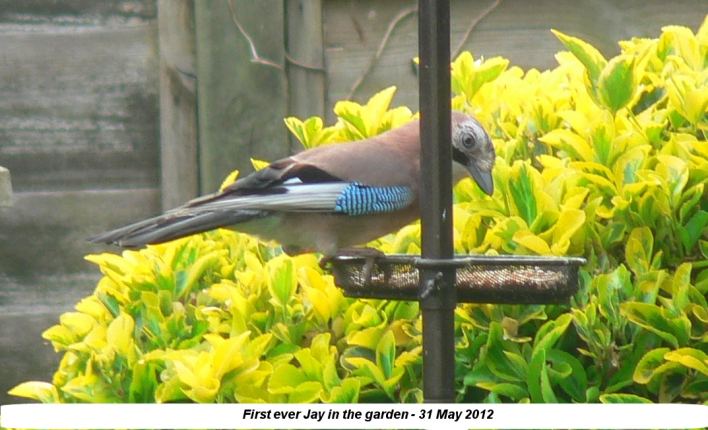
It flew off across the
gardens going eastwards. Jay is a fairly common bird
in the Lumley area of Emsworth and is sometimes seen
crossing Brook Meadow. This bird was probably from
that area, prospecting the garden feeders.
Jay is not a common
garden bird. At present it is ranked 27th on the BTO
GardenBirdWatch list with 11% of gardens reporting it.
It is more likely to be seen in the breeding season in
June with another peak in winter (Nov-Jan).
Great
Black-backed Gull nest
09.30 - I went down to
Slipper Millpond to check on the Great Black-backed
Gull nest on the centre raft. All was quiet with the
female gull sitting snugly on the nest with the chicks
beneath her.
17:30 - When I arrived
for my second check this afternoon the female Great
Black-backed Gull was standing up over the nest. I
could just make out the two chicks in the nest, but
they are still not mobile. The gull sat back down and
appeared to get settled for the night.
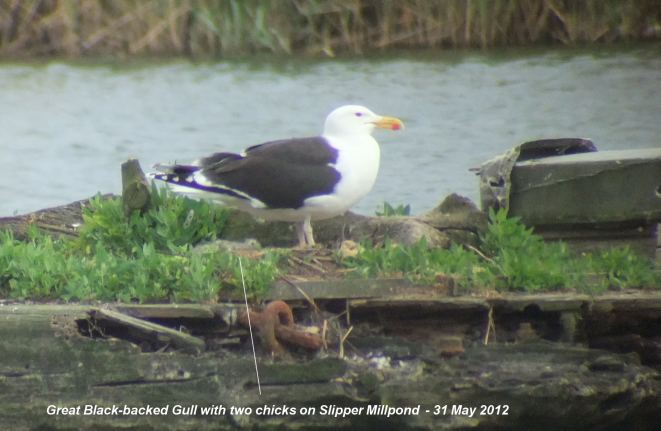
Interestingly, a
Lesser Black-backed Gull was on the pond when I
arrived. At first I thought it was the male Great
Black-backed Gull, but the smaller size was obvious.
It perched briefly on top of the nest box on the south
raft where I could see its yellow legs. After a few
seconds it was driven off by the resident Coot. There
were also two immature Herring Gulls and one
possibly immature Lesser Black-backed Gull on the
pond, though I am not sure of the latter.
Meanwhile the Coot
family with two chicks from the north raft are
doing well and the chicks are growing. Here is a snap
of them taken today by Patrick Murphy
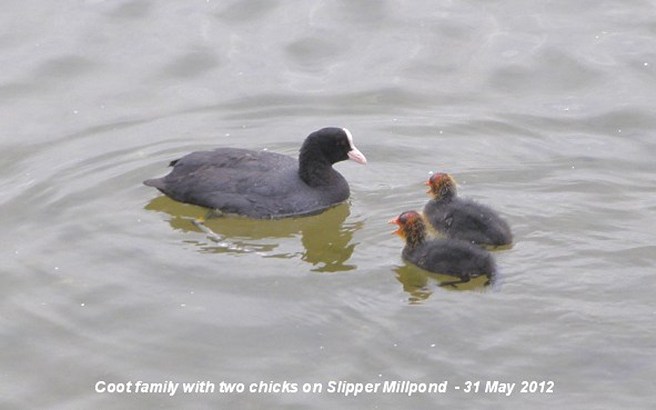
Dolphin
Creek
There is a fine
display of flowering Tree Mallow at the entrance to
the Dolphin Creek wayside at the end of Queen Street.
Lesser Sea-spurrey is showing on the gravely path, but
no flowers as yet. Green Alkanet was a new plant for
this wayside, taking the total list to 72 with 45
having been found this year so far.
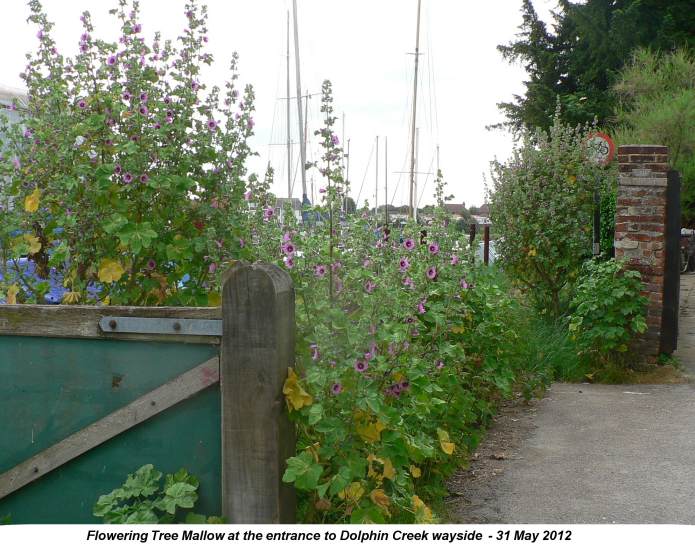
STANSTED
FOREST
This morning, Jean and
I had a pleasant walk through Stansted Forest from the
main car park on the Forestside road, down the Main
Avenue to Rowlands Castle, where we stopped for lunch
at the cafe.
We enjoyed the galaxy
of wild flowers and grasses along the edges of the
avenue, giving a fine kaleidoscope of colours; blue of
Germander Speedwell, white of Lesser Stitchwort, pink
of Common Sorrel, red of Red Clover, plus the
magnificent spikes of Foxgloves and the big yellow
daisies of Cat's-ear.

Other plants of
interest were my first Hemlock in flower, and a few
Common Spotted Orchids at the far end of the Avenue by
the Lime trees. It was interesting to compare the
rather similar small yellow flowers of Silverweed,
Cinquefoil, Tormentil and Yellow Pimpernel.
As for the grasses
they were dominated by False Oat-grass, Cocksfoot,
Meadow-grasses, Soft Brome, Yorkshire Fog and Barren
Brome, with a few Crested Dog's-tail and Quaking Grass
coming through. Other firsts for the year were Remote
Sedge and Wood Sedge.
WEDNESDAY
MAY 30 - 2012
EMSWORTH
Slipper
Millpond
09:30 - Both Great
Black-backed Gulls were on the raft this morning with
the female sitting on the nest. When she stood up, two
chicks were clearly visible, one tiny spotty chick can
just be seen in the following photo.
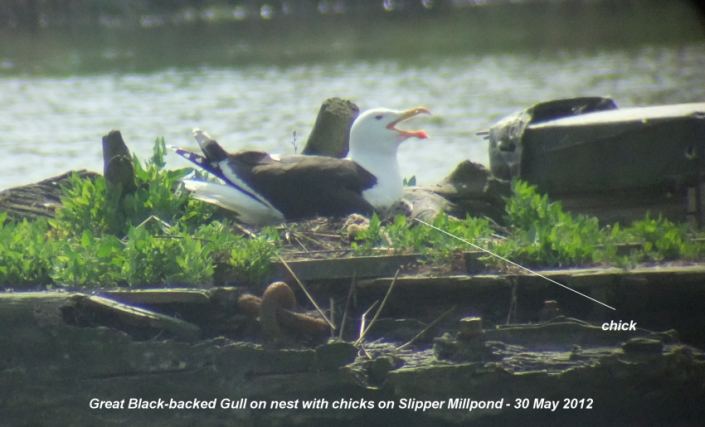
The Coot family with 2
chicks is still on the north raft.
The Mallard family
from Lesley Harris's garden is now down to 4
ducklings. However, Brendan Gibb-Gray showed me the
female Mallard that had returned to the nest on his
patio for a second try, presumably having lost her
previous brood of 13 ducklings.
I noticed that the
Lesser Sea-spurrey that grows through the cracks in
the path near the western kissing gate was just
starting to flower.
Lillywhite's
path wayside
The small verge
outside Lillywhite's Garage is now blossoming with
flowers and grasses. Two Viper's Bugloss are in flower
along with Purple Toadflax, White Campion, Cat's-ear
and Nipplewort which is a newcomer for this wayside.
Spiked Sedge is now showing well at the eastern end of
the main path. Three more new plants for this wayside
were Smooth Sow-thistle, Cut-leaved Crane's-bill and
Black Medick take the grand total for this wayside to
102 with 70 found so far this year.

Brook
Meadow
I had my first
Banded Demoiselle (male) in the south eastern
corner of the south meadow. What beautiful damselflies
these are.
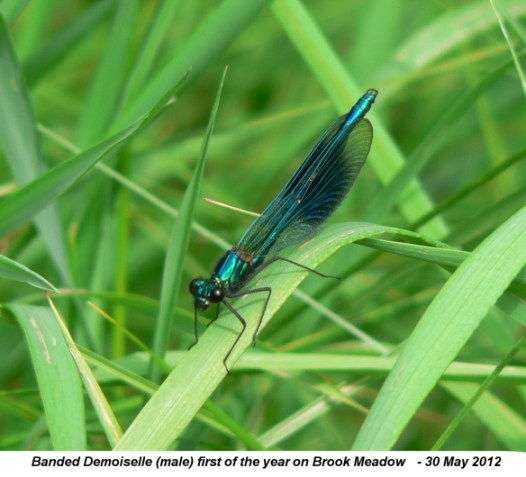
Large Red
Damselfly and Azure Damselfly were both on the
Bramble path. Three Speckled Wood butterflies were
chasing around near the south bridge in Palmer's Road
Copse.
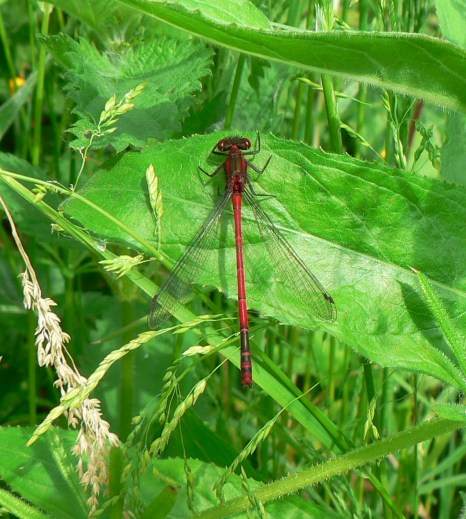
False Fox Sedge is
showing well in the usual spot at the start of the
Bramble path in the south meadow. Water Mint is also
flourishing close by, smelling good, though not yet in
flower.
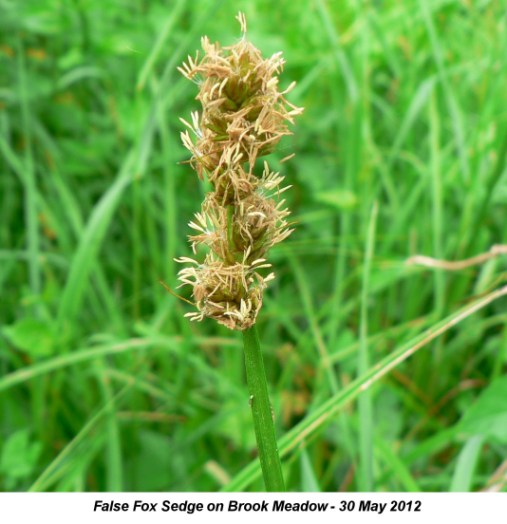
At 07.30 this morning,
Maurice Lillie saw a female Roe Deer leap from
the river bend in the northwest corner of the meadow,
up onto the bank of the Seagull Lane Patch. It sped
around the thorn tree, over the fence into Seagull
Lane path and turned right under the railway bridge.
This was the first deer sighting on Brook Meadow this
year.
OTHER
NEWS
Buzzards
saved
The RSPB is pleased to
announce that an outpouring of public concern for a
much-loved bird has encouraged Richard Benyon - the
Wildlife Minister - to drop proposals to licence the
destruction of buzzard nests and to bring adult
buzzards into captivity around shooting
estates.
Hand-feeding
Hummingbirds
Maurice Lillie sent
the following delightful photo of a lady living in
Louisiana USA hand-feeding Hummingbirds using a little
red dish filled with sugar water.
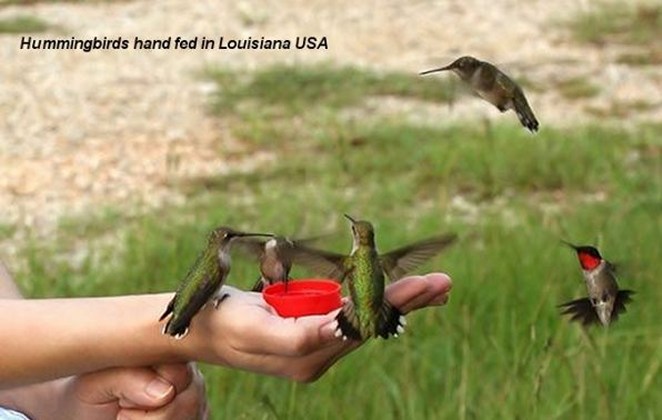
TUESDAY
MAY 29 - 2012
EMSWORTH
Great
Black-backed Gulls
09:15 - All was quiet
on the pond when I went down to check on the Great
Black-backed Gull nest this morning. The gull was
sitting on the nest with a Coot in the nest box
nearby. The Coot family with 2 chicks were near the
bridge as were the Mallard family with 6 ducklings.
17:00 - However, when
I checked again this afternoon, the sitting gull was
unusually restless, suggesting she had chicks. I could
also see a broken egg shell on the edge of the nest.
The gull got up briefly and I could see two chicks in
the nest and maybe more.
Here is my
digiscoped photo showing the broken egg shell
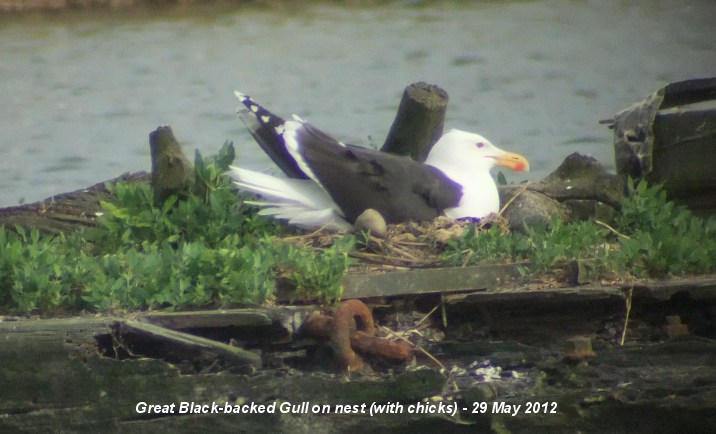
Peter
Pond
Two Reed Warblers were
singing in the Peter Pond reedbeds.
A Large Red
Damselfly was on the reeds to the north of Peter
Pond - the first of the year.

BROOK
MEADOW
Birds
I heard two
Whitethroat singing. The regular bird on the west side
of the north meadow plus a new songster in the
brambles in the north end of the Seagull Lane patch. A
Cuckoo was calling from the Lumley area.
Butterflies
Red Admiral on the
Seagull Lane patch. Common Blue on the Lumley area.
Plants
I had a mooch around
the recently cleared area on the Seagull Lane patch
near the Oak tree plantings where the ground was
relatively bare. I found several interesting new
plants not seen for a while. Scented Mayweed, was
prominent with some flowers out and having a strong
sweet aroma. Common Fumitory was widespread in
this area, the first I have recorded on Brook Meadow
since 2004. Lesser Swine-cress was everywhere,
far more than I have ever seen before on the Brook
Meadow site.

The Southern Marsh
Orchids are opening their bright pink flowers in the
orchid area. I saw the first spikes of Yorkshire Fog
on the orchid area.
Common Spike-rush was
out on the Lumley area, a good month later than last
year and at least 2 weeks later than usual. Silverweed
is flowering better than I recall having seen it
before.
Lumley
Road hedge cutting
I met Penny Aylett who
was fuming about the severe cutting of the hedgerow
all along Lumley Road from Peter Pond to the Lumley
cottages by the West Sussex Highways Essential
Maintenance Works. She had lived here for 30 years and
had never seen the hedges cut in this awful manner.
When I got there the
two workers had finished the job. As Penny said, the
cutting was very severe and the road widened by
several feet. I suggested to one of the workers that
this was the wrong time of the year for hedgerows to
be cut with birds still nesting and he agreed the work
should have been done in the winter. However, he told
me a complaint had been made by a resident about a car
having been scratched by the hedges and the Council
responded immediately by cutting them down. How
utterly pathetic.
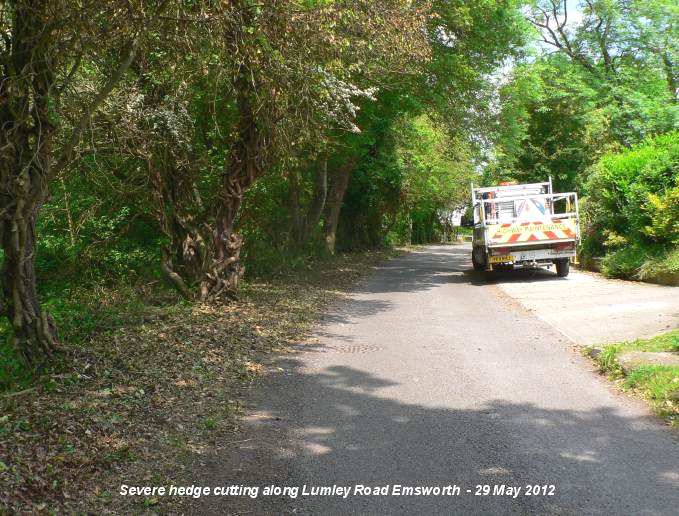
Clearly, no attempt
had been made to establish whether any birds were
nesting in the hedgerow before cutting began which is
highly likely. Also, no consideration had been given
to the fact that this is part of the Brook Meadow
Nature Reserve (SINC). The actions could be breaking
The Wildlife & Countryside Act 1981 which states
that it is an offence to intentionally take, damage or
destroy the nest of any wild bird whilst it is in use
or being built. I shall be communicating my feelings
to the WSCC.
MONDAY
MAY 28 - 2012
EMSWORTH
Slipper
Millpond
09:00 - The female
Great Black-backed Gull was sitting on the nest on the
centre raft. We are still waiting! Don't say I have
miscalculated again.
A coot was established
in the nest box on the raft and its mate was in the
water nearby. When I arrived the male Great
Black-backed Gull was perched on top of the nest box
on the north raft. I watched in great surprise as one
of the resident Coots shot across the water to drive
the gull away, and it went! The Coot family with two
chicks from that nest box was on the water near the
Hermitage Bridge.
The Mallard family
from Lesley Harris garden is now down to six
ducklings.
Waysides
news
Jane and I continued
our regular waysides surveys this morning and
discovered yet another new plant to take the total
waysides list to 299. Salsify on the Beacon Square
allotments path.

We almost had another
new one, but the mowers got there first! See the
waysides news blog for the full report plus
photos.
http://www.emsworthwaysides.hampshire.org.uk/few-NEWS-2012a.htm
Brook
Meadow
Richard Somerscocks
found plenty to see on Brook Meadow yesterday
including a pair of Common Blue butterflies in the
Lumley area of the meadow. Quite a lot more Ragged
Robin are now out. There were also a lot of Azure
Damselflies around and in addition a couple of
Blue-tailed Damselflies. The male in Richard's
photo must be very fresh since the thorax is still
green - it will turn blue in time.
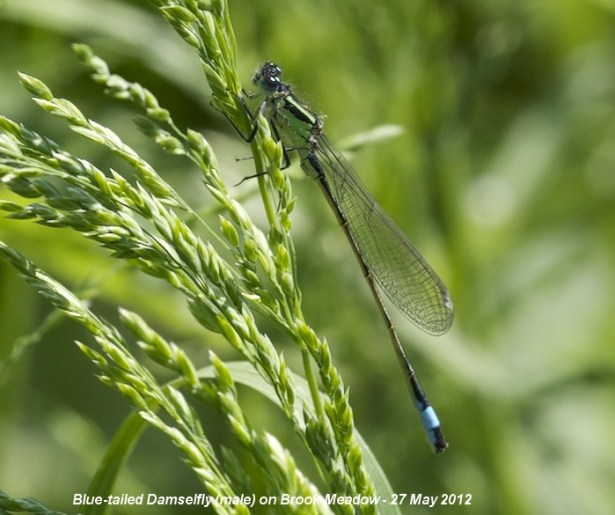
Peter
Pond
Richard thought there
were two Reed Warblers in the Peter Pond reedbeds but
they were difficult to spot.
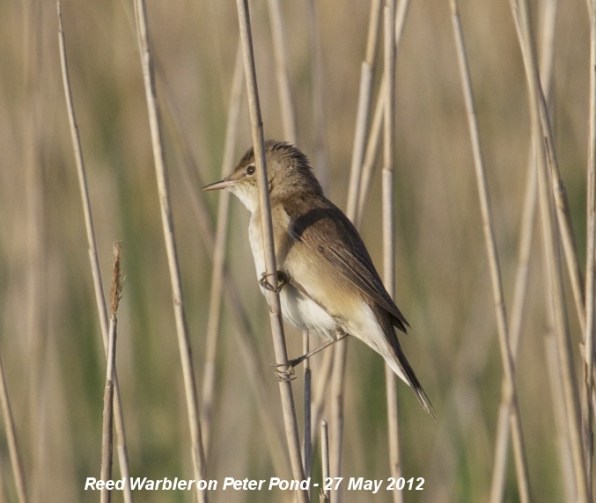
SUNDAY
MAY 27 - 2012
EMSWORTH
Slipper
Millpond
09.30 - The female
Great Black-backed Gull was sitting on the nest with
her beak wide open, trying to keep cool on a very hot
morning. The Coot family from the north raft with 2
chicks were on the pond near the Chequers Quay
buildings. A Mallard with a family of 7 young
ducklings was moving along the eastern edge of the
pond, keeping well awy from the gulls. This is
probably the remains of the family with 10 ducklings
that Lesley Harris rescued from her garden on May 24.
18:00 - No change with
a Great Black-backed Gull still sitting on the nest.
Tomorrow must be D-Day!
Brook
Meadow
Whitethroat was
singing as usual from the west side of the north
meadow. I have not heard the bird on the causeway for
a while and I suspect we have just the one Whitethroat
on Brook Meadow this year.
I could not see any
Festulolium Hybrids grasses along the NE path. Grasses
and sedges are seriously delayed this year.
The Southern Marsh
Orchids are now starting to open their flowers. I
counted a total of 10 plants, which is an increase in
three over last year. It looks as if they are slowly
spreading.

Swifts
I counted 6 Swifts
feeding over the Bridge Road area this morning. The
most so far this year.
HAVANT
WILDLIFE GROUP
Chris Cope reported on
yesterday's walk on North Common Hayling.
See the report and
photo at . . . Saturday
walks - reports 2012
The
sightings included a rare Wild Gladiolus (or possibly
Eastern Gladiolus)
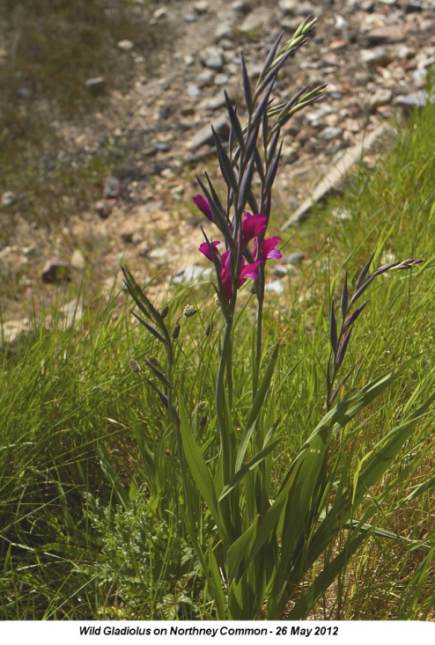
SATURDAY
MAY 26 - 2012
EMSWORTH
Swifts
over Bridge Road
We had four Swifts
feeding over the gardens at the rear of Bridge Road on
and off for much of the day. At times they swooped low
over our garden which is the first time we have seen
them doing this year.
Slipper
Millpond
10:00 - The nesting
situation was the same this morning, with both Great
Black-backed Gulls on the centre raft and one sitting
on the nest. My revised predicted hatching date is
Monday May 28.
I checked again at
17:00, but there was no change. However, the male gull
was on pond where it caught and ate a fish, probably a
Grey Mullett. They could be a useful source of food
for the gulls as there are hundreds in the pond.
The Coot family from
the north raft with two chicks were on the water near
the Chequers Quay houses. Hopefully, they will stay
well away from the gulls.

The first Sea
Club-rush was flowering on the east side of the
pond
Peter
Pond raft
The mystery platform
that David Gattrell constructed on the east side of
the pond is revealed as a floating raft and is now
anchored in the centre of the pond. This is the first
ever proper raft on Peter Pond and will no doubt be
appreciated by nesting birds, probably Coot and
Mallard and even Mute Swans. However, I doubt if David
would welcome Great Black-backed Gulls nesting there!
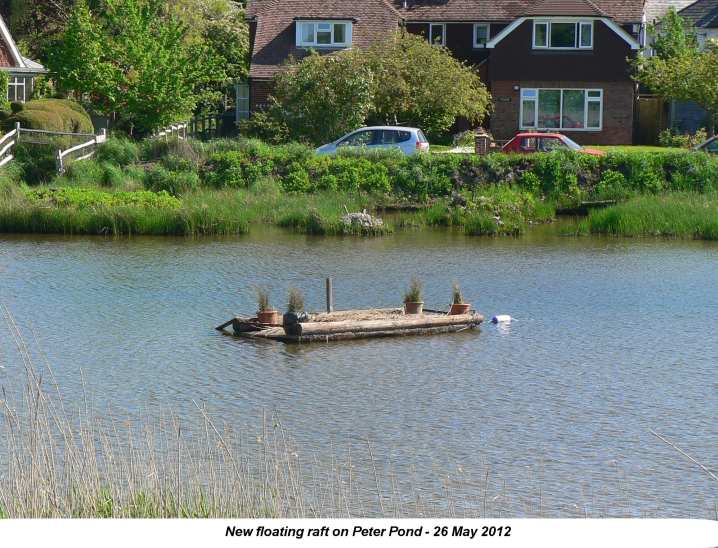
Just one Reed Warbler
was singing from the reedbeds to the north of Peter
Pond.
My first
Goat's-beard of the year was flowering on the
west side of Peter Pond on the path leading to
Gooseberry Cottage.
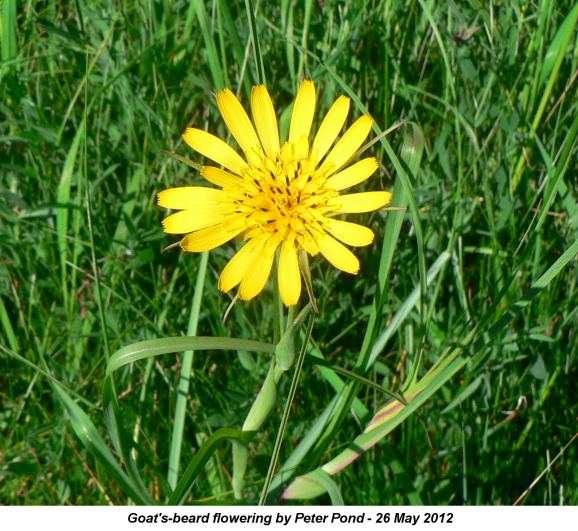
Brook
Meadow
The first Marsh
Foxtail of the year is now showing in the "Lumley
puddle" area.
Three Ragged Robin
flowers are now open on the Lumley area.
A female Azure
Damselfly was flying around the Lumley area. Possibly
the same one that Richard Somerscocks saw recently.
My first Common
Blue butterfly of the year feeding on buttercups
on the Lumley area. Two weeks later than last year.
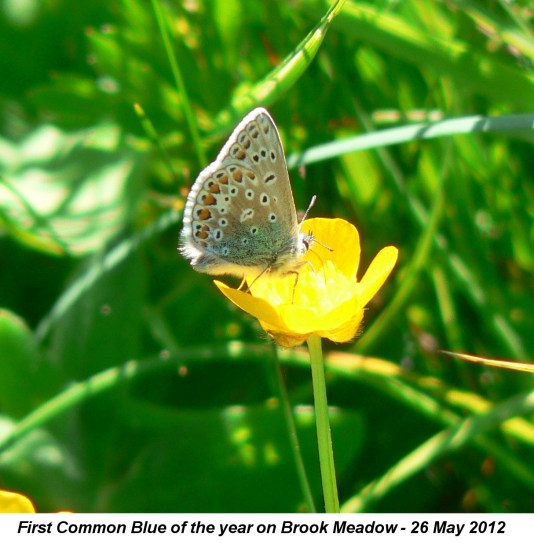
Plants
White Stonecrop
is flowering on the edge of Emsworth Millpond towards
the southern end of Beach Road.
FRIDAY
MAY 25 - 2012
SLIPPER
MILLPOND
Great
Black-backed Gull nest
09.00 - A Great
Black-backed Gull was still sitting on the nest with
no sign of any chicks. Also on the raft were 3 Mallard
and a Coot in the nest box. The two Coot chicks were
on the northern raft.
17.00 - No real
change. Both Great Black-backed Gulls were on the
raft. While I was there they changed over the brooding
duties, which enabled me to get a close look at the
nest, but there were definitely no chicks there.
Hatching
date
Clearly, I
miscalculated when the chicks would be hatched. The
incubation period for the Great Black-backed Gull is
27-28 days. I first saw the gulls on the centre raft
on April 22 and Tom Bickerton first saw nest building
activity on April 24. I first clearly saw a gull
sitting on a nest on April 27. Assuming laying of 2-3
eggs over the next 3 days means incubation proper
started on April 30. So, 28 days from then gives a
hatching date of Monday May 28.
Great Black-backed
Gull chicks are semi-precocial which means they are
able to move on hatching, though not far and remain
dependent on the parents for feeding. Complete
fledgling does not occur for 55-60 days after
hatching, which takes us to the end of July, though we
should expect to see the chicks testing their powers
of flight before that date.
Mallard
family
The Mallard family
with 10 ducklings that Richard Somerscocks saw on
Dolphin Lake yesterday came from the garden of Lesley
Harris. Lesley's house overlooks the eastern harbour.
Here is Lesley's story of how they got
there:
"The female Mallard
who nests twelve foot up in our Wire Plant creeper
pushed her ten ducklings out of the nest in the early
morning. For hours they cheeped in our garden, but we
needed to wait for the tide to reach our sea wall at 2
o'clock. Then battle commenced. In the blazing heat we
put on thick clothing and gloves to protect ourselves
from the mother's onslaught. She was fended off and
the young were thrown over the sea wall. Dad came to
greet the mother and offspring and they swam together
into Dolphin Creek towards the danger zone of the
Greater Black Backed Gulls."
WAYSIDES
NEWS
Viper's
Bugloss
A single plant of
Viper's Bugloss was flowering on the small grass verge
outside Lillywhite's Garage at the end of Queen
Street. Not only was this the first Viper's Bugloss on
an Emsworth wayside, but also, the first I have ever
seen anywhere in Emsworth! This takes the total
waysides plant list to 296, with 98 on the
Lillywhite's path wayside. Not far to go now to catch
up with Brook Meadow's 335.
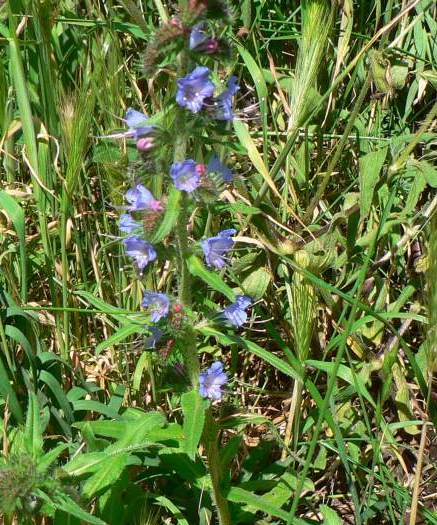
THURSDAY
MAY 24 - 2012
SLIPPER
MILLPOND
Great
Black-backed Gull nest
09.30 - What I think
was the male Great Black-backed Gull was sitting on
the nest with its beak open, as it was yesterday,
presumably trying to keep cool in the hot
temperatures. I spoke to Brendan Gibb-Gray's neighbour
who thought she saw one of the gulls feeding a chick
yesterday. However, I was at the pond for the next
hour, occasionally checking the nest through my scope,
and did not any evidence of chicks.
17:00 - I checked
again this afternoon and there was no change in the
situation. However, the gull did stand up on the nest
to adjust what I assume were the eggs; there was
definitely no chicks in the nest. Interestingly, a
Cormorant was also on the raft drying its wings.
Coot
nests
The Coot pair nesting
on the north raft have two chicks. They actually
ventured onto the water with one of their parents.
There was also one chick in the nest box on the south
raft, but nothing in the nest box on the centre raft
where the gulls are nesting.
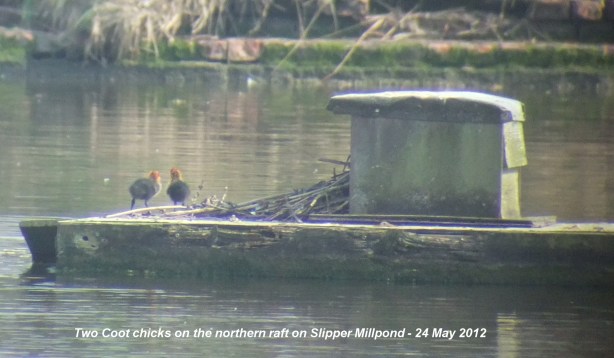
Mallard
families
A small Mallard family
of mum and two mature ducklings were swimming around
the Chequers Quay buildings. This is probably the
remains of the family of 13 ducklings that hatched on
Brendan Gibb-Gray's patio about 3 weeks ago.
Richard Somerscocks
saw a Mallard with a clutch of 10 very young ducklings
on Dolphin Lake, clearly a new family in the area.

Plants
Red Fescue and a red
form of Perennial Ryegrass were growing well along the
edge of Dolphin Lake, where the leaves of Prickly
Lettuce are just starting to emerge. However, there
was no sign of any Sea Club-rush spikelets. Shoals of
Grey Mullett were swimming in the shallow water on the
western side of the pond.
BROOK
MEADOW
Richard Somerscocks
went down to Brook Meadow late afternoon. He saw some
butterflies including Orange Tip, a White, Peacock,
Comma and a couple of Holly Blues. There were also
several Silver Y moths around. These are often
seen on Brook Meadow at this time of the year. Richard
notes they are migratory, coming up from the
Mediterranean and can arrive in quite large numbers so
one can expect more.
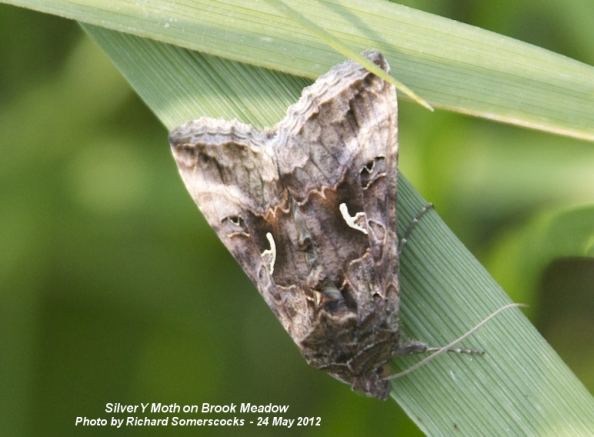
There were also a couple of Azure Blue Damselflies
flying around. Here is a female by Richard.
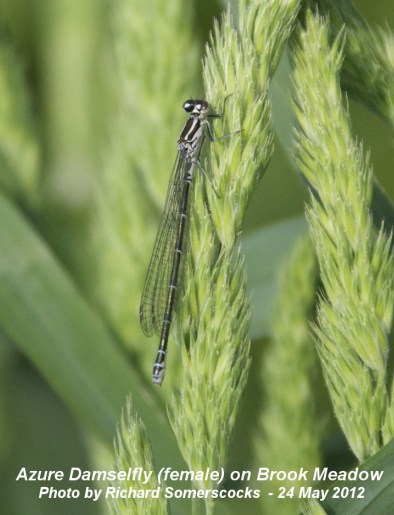
Finally, just downstream of the S bend Richard saw a
Water Vole swimming down river. After 20 metres or so
it got out onto the west bank and started feeding
giving some quite good views.

Chichester
Peregrines
The four Peregrine
chicks in the nest on Chichester Cathedral are growing
fast. They are moving around the nest area and are
losing their white downy feathers. The dark mature
flight feathers are starting to come through. See the
live web cam at . . . http://www.chichesterperegrines.com/live-webcam.html
CONCERN
OVER BUZZARDS
The RSPB is stunned by
Defra's plan to allow the destruction of Buzzard nests
and to permit them to be taken into captivity to
remove them from shooting estates. The Society
believes this intervention against one of England's
best-loved birds of prey will set a terrible precedent
and prove to be a costly and unnecessary
exercise.
The move by Defra
followed lobbying by the pheasant shooting industry.
Buzzards usually scavenge on animals which have
already died, but they will sometimes take young
Pheasants which are released for sports
shooting.
The Buzzard was
eradicated from large swathes of Britain following
decades of persecution. Legal protection and a general
warming of attitudes towards buzzards and other birds
of prey on the part of many lowland land managers, led
to buzzards recovering across the UK: a fantastic
conservation success story.
Pheasants are not
native to the UK. Around 40 million birds are released
every year for shooting. The impacts of this practice
on wildlife have been poorly documented, but serious
questions have been raised about the impact such a
large injection of captive-reared birds might have on
the predator-prey balance in our countryside.
Buzzards will take
young pheasants from rearing pens, given the
opportunity, but the RSPB believes the issue can be
managed without destroying nests or moving buzzards.
Measures include providing more cover for young
pheasants in release pens, visual deterrents to
discourage birds of prey and providing alternative
food sources.
The current government
would seem to have enough worries about accusations of
being being rich, upper class and out of touch without
adding Britain's millions of bird watchers to the
fray. I for one will be writing to my MP if this looks
at all likely to go ahead and I would urge you all to
do the same!
WEDNESDAY
MAY 23 - 2012
HERMITAGE
MILLPONDS
Great
Black-backed Gull nest
When I arrived to do
my daily check at 09.00 the female Great Black-backed
Gull was sitting on the nest on the centre raft,
accompanied by the female 'Polish' Mute Swan (with
pink legs) from the failed Peter Pond nest, a
Black-headed Gull and a Coot near the nest box. The
male bird arrived back on the raft at 09.30 when a
change over of incubating duties took place. The
female immediately flew off to find food, leaving the
male sitting on the nest, gasping in the hot sunshine.
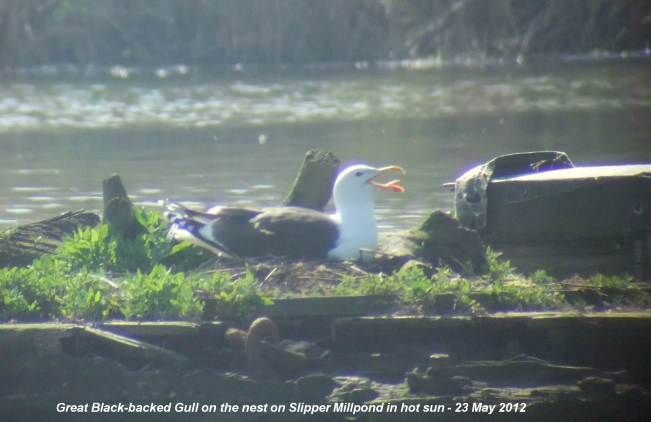
Reed
Warbler
At long last a Reed
Warbler was singing in the reedbeds to the north of
Peter Pond, about 4-6 weeks later than usual. In fact,
I thought I heard two singing at one time.
BROOK
MEADOW
Ragged
Robin
The first Ragged Robin
flower of the year was out on the Lumley area. I could
only see one flower open. This is the latest they have
ever been; they are usually well open by the second
week in May. Last year the first flower was open on
April 26, though this was exceptional.
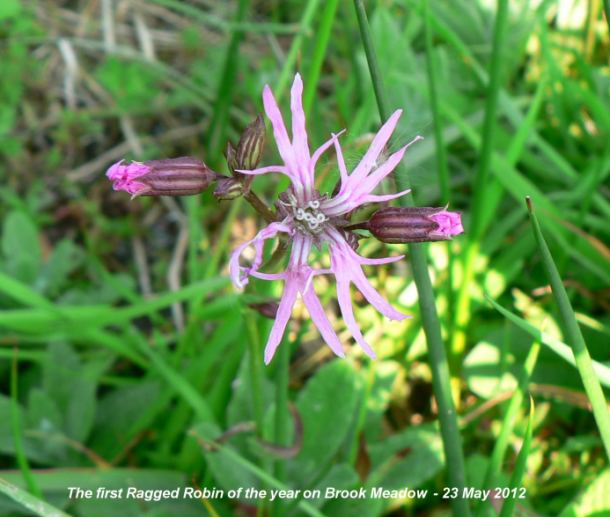
Sedges
There is a good growth
of Divided Sedge in the south eastern corner of the
south meadow as well as on the Lumley area. I found
the first False Fox Sedge of the year on the Lumley
area, at least 2 weeks later than usual and a whole
month later than last year! Sedges I have not seen as
yet are Remote Sedge, Grey Sedge, Hairy Sedge, Spiked
Sedge Common Spike-rush and Sea Club-rush .
NORTH
THORNEY
Parking at the end of
Thornham Lane I walked along the old NRA track across
North Thorney and down the west side of Thorney to
Little Deeps. I was surprised by the large amount of
water in the field owned by Chichester Harbour
Conservancy to the north of the track, just like a
lake. I have never seen it like it before.
The old Marina Farm
stables is now a somewhat intimidating place to walk
through with lots of vehicles, dogs and hundreds of
horses grazing on grassless fields. What is going on
here?
Birds
A Cuckoo was calling
from the bushes to the south of the track. but no
sound of Turtle Dove.
I have not heard one
this year. Several Swallows were flying around the old
stables. Cetti's Warbler was singing. Reed Warbler was
singing in the reeds at Little Deeps and Reed Bunting
was active in the reeds. But no Sedge Warbler. A Mute
Swan was at the nest on the island on the Little
Deeps, but there did not seem to be any eggs in the
nest.
Plants
Bee Orchid buds are
starting to show at the start of the track, but no
flowers as yet, but Bird's-foot Trefoil was in flower.
Three Red Hot Poker plants were flowering at the start
of the track to Little Deeps. I thought they had all
been dug up! I like them.
I found the following
sedges, Spiked Sedge, Glaucous Sedge and Distant
Sedge, plus Saltmarsh Rush, Sheep's Fescue and Sea
Plantain were flowering along the edge of the track
near Little Deeps.
TUESDAY
MAY 22 - 2012
Great
Black-backed Gull nest
9am - What looked like
the male Great Black-backed Gull was sitting on the
nest on the centre raft. No sign of any hatching as
yet, but it should be close The Coot was still in the
nest box on the raft. Two Black-headed Gulls were also
on the raft, though they are unlikely to stay once the
second Great Black-backed Gull returns.
Patrick Murphy went to
the pond this afternoon at about 4.30pm. Initially
only the female was on the nest but was joined shortly
by her mate. Patrick also saw the Coot chick on the
northern raft. That Mallard is taking a risk!
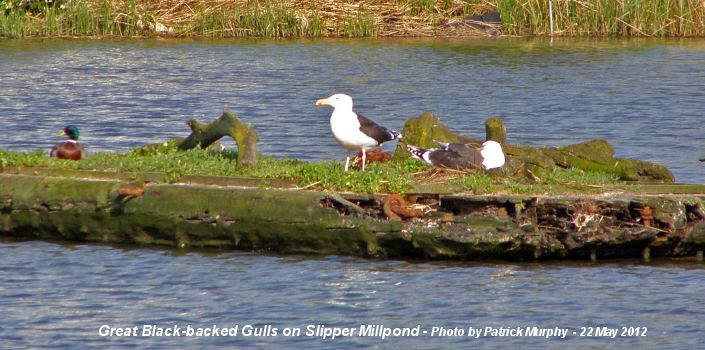
Beaked
Hawk's-beard
Following the tips
from Ralph Hollins about distinguishing Beaked
Hawk's-beard and Smooth Hawk's-beard I had a look at
the numerous plants growing along the ege of the
Washington Road path wayside, north of the road
bridge. Many of the plants were in flower and the
flowers were generally 15mm or more indicating they
were Beaked Hawk's-beard. Smooth Hawk's-beard flowers
are smaller than this. This identification was
supported by the fact that most of the stems were very
rough though I did find a few with smooth stems!
Smooth Hawk's-beard has smooth stems. I feel fairly
cionfident in putting these down as Beaked
Hawk's-beard.
New
wayside plants
I found a number of
other plants of interest while looking around the
Washington Road wayside. New plants for this wayside
found were Black Medick on the Glenwood School
embankment, Hairy Tare along the western side, plus
Weld, Green Alkanet and Hemlock just before the posts
at the entrance to the Recreation Ground. These take
the list for this year to 75 and the grand total to
125.
I also found what
looked like False Brome, rather like Barren Brome but
with spikelets on short stalks, on the edge of the
path by the pony field. However, the leaves were not
hairy as they should be, so I shall need to look at
this one again.
Other plants of
interest: Balm was still present despite the
reconstruction work just north of the railway bridge.
There a very good growth of Swine-cress along the edge
of the path north of the railway. Rough Meadow-grass
and Hairy Tare are flowering.
Dead
Rowans
A lady asked me today
why trees were dying in Christopher Way. I did not
know they were dying, so I had a look this afternoon.
One Rowan outside Number 22 was not in a good state
with its upper parts rotted and many small dead
branches on the ground. The bark appeared to be
infected on the main trunk. Another Rowan by the
southern bend in the road was completely dead. I have
not been able to find out much about Rowan diseases,
but the species is vulnerable to fungal attack and
this might be the problem here, though I did not see
any visible signs of fungi growing near the tree.
Swifts
It was a perfect
evening for Swifts. Warm, cloudless with little wind.
And they came, just five of them were flying around
the houses and gardens in Bridge Road at around 8pm.
They were clearly feeding on insects. This was our
first proper sighting of them this year.
Nightingale
Survey
For the nocturnal part
of the BTO 2012 Nightingale survey, Terry and Paul
Lifton visited Marlpit Lane last night. They heard
just one Nightingale and no Nightjar. They stayed
around Marlpit Lane for about 30 minutes and the one
bird was singing the whole time. Unmated Nightingales
apparently continue singing through the night, so
presumably this bird had yet to find a mate.
I visited Marlpit Lane
this afternoon at 2pm, where I found one Nightingale
singing in much the same place described by Terry and
Paul Lifton last night - about 200 metres north of the
footpath entrance. Apart from that exceptional five
songsters I heard on May 13th, the most I have heard
at one time is two. This makes me wonder if some of
those I heard on May 13 were just passing through. But
five are now entered on the official survey.
Marlpit
Lane site
I had a walk around
the wasteland site to the east of the lane. There was
another birder there from Pagham Harbour watching and
listening for Nightingales and Turtle Doves. It was
the first time he had been on the Marlpit Lane site
and thought it a gem! I heard both Whitethroat and
Lesser Whitethroat but not Turtle Dove. A Buzzard was
flying over the plantation to the north, probably
nesting in there. As for flowers, I could see only a
few Creeping Cinquefoil flowers whereas thousands were
out at this time last year. Others in flower included
Scarlet Pimpernel and Crosswort.
Crow
takes Goldfish
Peter Milinets-Raby
watched with astonishment (and horror) this morning as
a Carrion Crow grabbed his prize 17+cms Goldfish out
of his garden pond! It bashed it on the ground,
stabbed it several times with its bill and flew off
with its prey! Peter said it all happened so quickly,
even the Goldfish didn't see it coming! But, stupid
Goldfish, as it always basks near the surface of the
pond on warm days!
That was quite a
catch! Pity about the fish, but the Crow must have
enjoyed the meal.
MONDAY
MAY 21 - 2012
SLIPPER
MILLPOND
Great
Black-backed Gull nest
I checked the Great
Black-backed Gulls a couple of times today, once at
09.30 and again at 17.00. One bird was still sitting
firmly on the nest with no sign of any chicks. Its
mate was not present on either occasion.
Coot
Interestingly, a Coot
was back in the nest box on the same raft as the gulls
with another nearby, presumably its mate. Yesterday,
it looked as if the nest had been totally predated by
the gulls. However, there was no sign of the chick
that was present earlier. Maybe, the pair are trying
for another brood? What amazingly resolute birds they
are, carrying on regardless of the obvious threat to
their own safety.
I could see the one
chick in the northern raft being fed by its parents,
sensibly not straying far from the nest box.
BROOK
MEADOW
Water
Vole
Debbie Robinson saw
her second Water Vole in a week at 4.30pm. It was in
more or less the same place as my sighting the week
before, ie, looking from the Palmers Road carpark
viewing fence across to the sluicegate, and the vole
was between the sluicegate and the visible vole hole
entrances on the far bank. He sat nibbling like a
hamster and then turned and 'walked' off away from me
into the undergrowth.
Debbie also had a frog
hop across her path - about an inch long - not a
froglet by any means - in the grass near where the
picnic table used to be.
WAYSIDES
NEWS
Jane Brook and I
continued our surveys of the Emsworth waysides this
morning. We did the four main sites in North Emsworth.
See the waysides web site for the full report with
photos . . . http://www.emsworthwaysides.hampshire.org.uk/few-NEWS-2012a.htm
We started at the
Greville Green (west) site where we found a fine
display of Bulbous Buttercups.
The Common Spotted
Orchid leaves were showing very well on this site.
We erected a stake behind the plant to protect it from
Council mowing around the edge of the site. Ransoms
were flowering on the edge of the path just west of
the main site.
This fenced area of
the Spencer's Field verge with litle public access has
a magnificient growth of grasses, including the first
Yorkshire Fog of the year. We found Thyme-leaved
Speedwell and clsw in flower. We were tempted to
re-identify Common Mouse-ear as Sticky Mouse-ear, but
the cluster of terminal flowers was not quite dense
enough.
We spent some time
examining the plants on the traffic island at the
junction of Southleigh Road and Horndean Road. We
found a number flowering for the first time including
Bird's-foot Trefoil, Buckshorn Plantain,
Thyme-leaved Speedwell and Red Fescue.
On the main Southleigh
Road (west) verge, we found what looked at first like
an exceptionally large Meadow Foxtail but I
subsequently confirmed it as an early Timothy -
first of the year. There was an amazing amount of Grey
Sedge which seems to come up almost anywhere. We were
surprised to find Balm on the edge of the cycleway.
We came across fine
displays of Greater Stitchwort and Germander Speedwell
in flower. The western verge past the entrance to
Southleigh Forest was lined with aromatic Cow Parsley.
SUNDAY
MAY 20 - 2012
SLIPPER
MILLPOND
Great
Black-backed Gulls
I had predicted May 20
as a possible hatching date for the Great Black-backed
Gulls, but there was no sign of anything happening
when I visited the pond at 10am this morning. Both
gulls were on the centre raft with the female on the
nest and the male standing imperiously nearby.
Coot
nests
The Coot nest box on
the centre raft was empty with no sign of either the
adult Coot or the chick that I saw there yesterday.
The barricade of twigs had been smashed down, clearly
indicating that the nest had been predated. A single
Coot was swimming around the raft, maybe the surviving
member of the pair.
The Coot on the north
raft was still tucked up behind its barricade of
twigs, though I could not see the chick that was there
yesterday. The Coot on the south raft was similarly
entrenched behind its twigs with one chicks clearly
visible.
Swifts
very late
We saw two Swifts
flying high over Bridge Road at about 8am this
morning. We did not see them again. Looking back
through my records since I came into this house in
1997, this is the latest arrival ever of Swifts.
WAYSIDES
NEWS
For full report and
photos go to . . . http://www.emsworthwaysides.hampshire.org.uk/few-NEWS-2012a.htm
Washington
Road path
Masses of plants are
burgeoning along the edge of the new path, not easy to
sort them out. The tall Hawk's-beards are still
baffling, though some of them have bristly stems with
orange under the petals, suggesting Beaked
Hawk's-beard.
Emsworth
Recreation Ground:
The grassland to the
west of the bowling club is covered with flowering
Bulbous Buttercups. However, there is an encroaching
growth of Blackthorn suckers which threatens to engulf
this area. This needs cutting back along with the
White Poplar suckers. Sweet Vernal Grass and Field
Wood-rush grow particularly well in this area and
later are Bent-grasses. Common Sorrel is also
flowering here.
Westbourne
Open Space
This wayside looks
beautiful with masses of tall grasses, mostly Meadow
Foxtail, waving gracefully in the breeze. Other
grasses included Soft Brome, Barren Brome, Wall
Barley, Tall Fescue (new), Red Fescue (with closed
leaf-sheaths),
New
Brighton Road Junction
Plants in flower: Red
Clover, Beaked Hawk's-beard, Red Fescue, False
Oat-grass, Wall Barley, Germander
Speedwell,
Bridge
Road car park
Plants flowering for
the first time on the wayside included Hemlock
Water-dropwort and Pellitory-of-the-wall. Wall
Speedwell was in flower under the Beech hedge with its
tiny bright blue flowers almost hidden by the
untoothed upper leaves. Leaves of Wall Lettuce are
also showing under the Beech hedge but no flowers as
yet.

FRIDAY
MAY 18 - 2012
BROOK
MEADOW
Tony Wootton had a
lovely morning in Brook Meadow, during which he saw 2
Blackcaps, a female Great Spotted Woodpecker, a
Whitethroat and a Chiffchaff carrying caterpillars for
its chicks. Three Swifts flew overhead - I have not
seen any over Bridge Road as yet. Tony also saw two
Cuckoos flying over the meadow going towards Lumley
Road, clearly indicating we have a pair in the local
area. He also a Green Woodpecker yaffling. Here are a
couple of his photos.
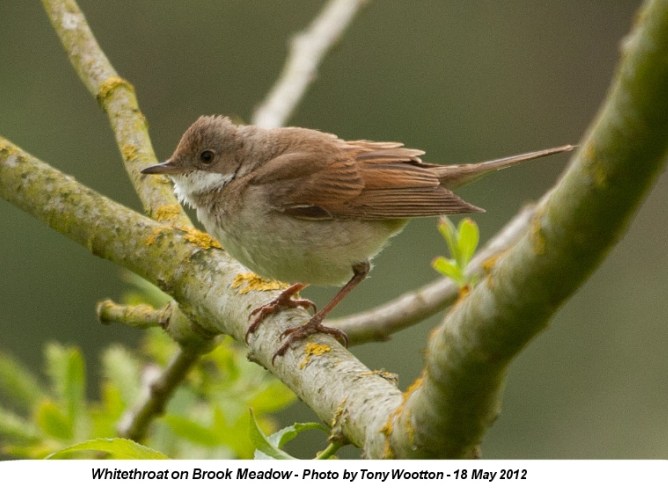

SLIPPER
MILLPOND
Tony watched a pair of
Black-headed Gulls dive bombing the Great
Black-backed Gulls that are nesting on the centre
raft. One of the Great Black-backed Gulls got fed up
with this and saw them off. Hatching must now be
fairly close. Possibly tomorrow?
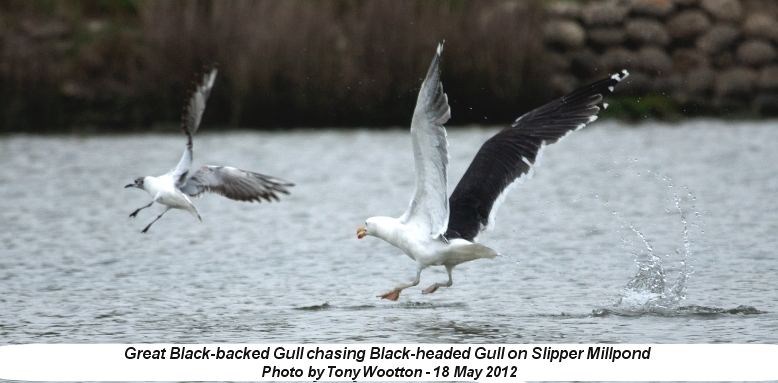
He was pretty sure
there was only one Coot chick in the nest box on the
centre raft. I thought I saw two yesterday, which
suggests one may have been taken. Not very surprising.
OTHER
NEWS
Bastard
Cabbage
Ralph Hollins cycled
down the Hayling Billy Line on Wednesday and, passing
the Saltmarsh Lane marsh, he saw that the seawall was
covered with a mass of yellow brassica flowers. On
closer inspection they turned out to be the Bastard
Cabbage that has been increasing its foothold there in
recent years. See Ralph's photo on his wildlife diary
for Wednesday May 16, particularly the 'Chianti
bottle' shaped seed pods that identify the plant. The
seaward end of the track leading to the seawall also
had a good show of Lesser Sea Spurrey and Subterranean
Clover. http://homepage.ntlworld.com/ralph.hollins/Diary.htm
Grasses
on waysides
The grasses are
growing well on the Havant Road verge wayside at the
top of Valetta Park. This morning I noted Meadow
Foxtail, Cocksfoot, False Oat-grass, Smooth
Meadow-grass, Rough Meadow-grass, Red Fescue and
Perennial Ryegrass (for the first time this year).
THURSDAY
MAY 17 - 2012
BROOK
MEADOW
Work
session
I went over for the
work session on Brook Meadow, mainly to take photos of
the volunteers at work. Rachel Moroney from The
Conservation Volunteers (the new name for BTCV) came
to carry out the annual inspection for insurance
purposes. The main task was clearing the edges of the
paths in preparation for the Herb walk this week.
For the full report
and photos go to the Brook Meadow diary . . .
http://www.brook-meadow.hampshire.org.uk/bm-diary-2012.html
The volunteers were
careful not to damage the fine display of Cow Parsley,
along the edges of the paths.
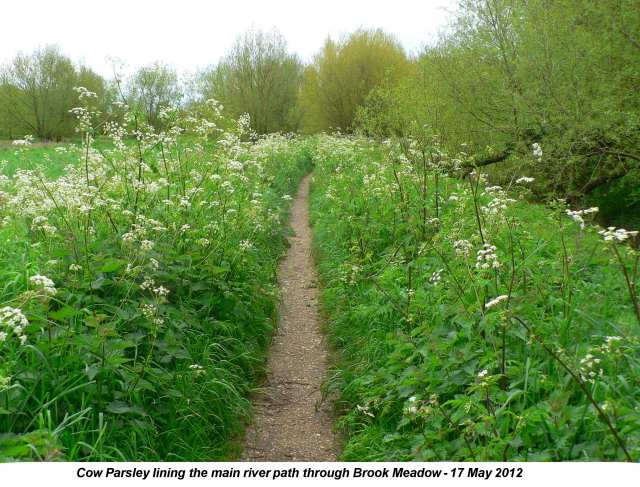
Two
Whitethroats
Two Whitethroats were
singing on the meadow this morning, one from the
Willows on the west side of the north meadow, about
100 metres south of the north bridge, the other from
bushes below the causeway.
Nuthatch
tapping
My wife drew my
attention to a tap-tapping from the large Crack Willow
just north of the north bridge this afternoon. I
thought at first it was just the tree creaking, but
the tapping was too regular. It certainly was not a
Great Spotted Woodpecker. Then we spotted a Nuthatch
high in the tree. I assume it was searching for
insects in the bark of the tree. It flew off towards
the north path as we were watching it. That was the
first Nuthatch sighting we have had for a while. I
wonder if they are nesting on the meadow?
Smooth
Meadow-grass
Smooth Meadow-grass is
not a common grass on Brook Meadow and some years I
have a job to find any at all. The key is to look for
it early as it flowers earlier than Rough
Meadow-grass. It differs from Rough Meadow-grass by
its short ligules. Today, I found a small growth on
the north section of the south meadow. Rough
Meadow-grass is fairly abundant in Palmer's Road
Copse. I also found some Smooth Meadow-grass on the
Lillywhite's path wayside, so it appears to be opening
generally.
Water
Vole
At 9am Penny Aylett
saw a Water Vole swimming along the edge of the river
bank just north of the south bridge.
SLIPPER
MILLPOND
Great
Black-backed Gulls
The Great Black-backed
Gull pair was on the centre raft as usual with one
bird on the nest. Unusually, one of the Mute Swan pair
was also on the raft, though it moved off while I was
there.
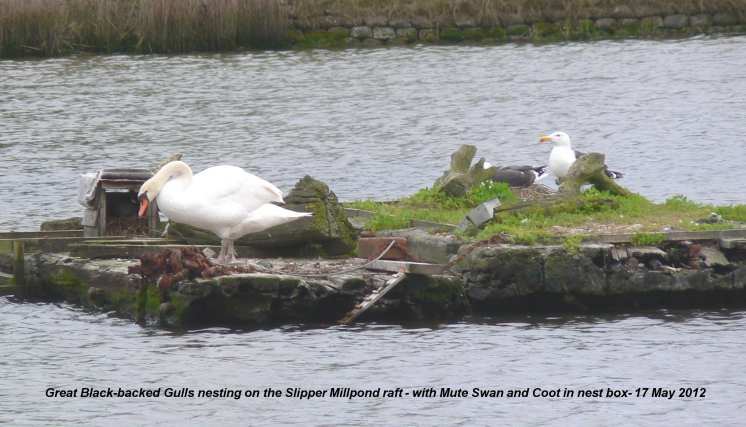
Coot
chicks
I caught a brief
glimpse of two Coot chicks in the nest box on the same
raft as the gulls. The chicks did not venture out of
the box while I was there, though they will be
vulnerable to the predatory gulls once they do. There
was no sign of any Coot chicks on either of the other
two rafts.
OTHER
NEWS
Common
Jellyspot fungus
Ralph Hollins solved
the mystery of the mass of orange jelly-like globules
that I discovered on a dead log in Hollybank Woods
yesterday:
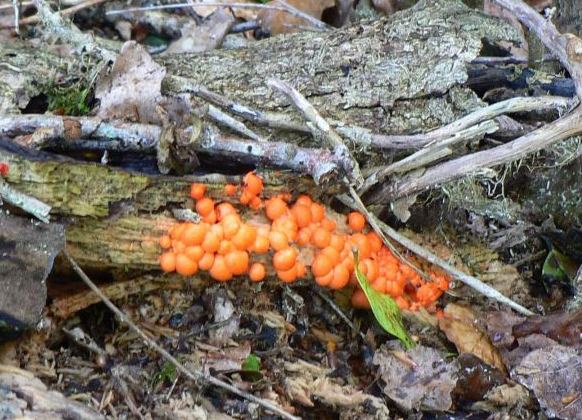
"Your photo suggests
to me Dacrymyces stillatus rather than Coral Spot
mainly because of the variability in the size of the
'spots'. Coral Spot has very small spots of a
consistent size while Dacrymyces has slightly larger,
more variable spots that fit Roger Phillips
description of them as 'gelatinous'. Checking with the
second of my three main books (Michael Jordan's
Encyclopaedia) I was put off by his photo of
Dacrymyces as showing a pale yellow colour but his
text says 'yellowish orange when damp, deeper orange
when dry'."
The official English
name for Dacrymyces stillatus is Common Jellyspot.
Chichester
Peregrines
The four Chichester
Peregrine chicks were ringed on the 15th of May - to
see pictures of them being ringed go to . . .
http://www.chichesterperegrines.com/ringing-of-chicks.html
Osprey
over Emsworth
Yesterday, D A Morgan
reported a pair of Osprey flying over Emsworth by-pass
(A27) for approx 10 mins at 11am. Barry Collins also
reported one at Pilsey Island Thorney throughout the
morning today, plus 174 Ringed Plovers, 400 Dunlin,
60+Sanderling, 12 Barwits, 7 Knot, 9 Turnstone etc and
a male Wheatear. Nearby a Short-eared Owl was foraging
over fields.
For
earlier observations go to . .
May
2012 (1-16)